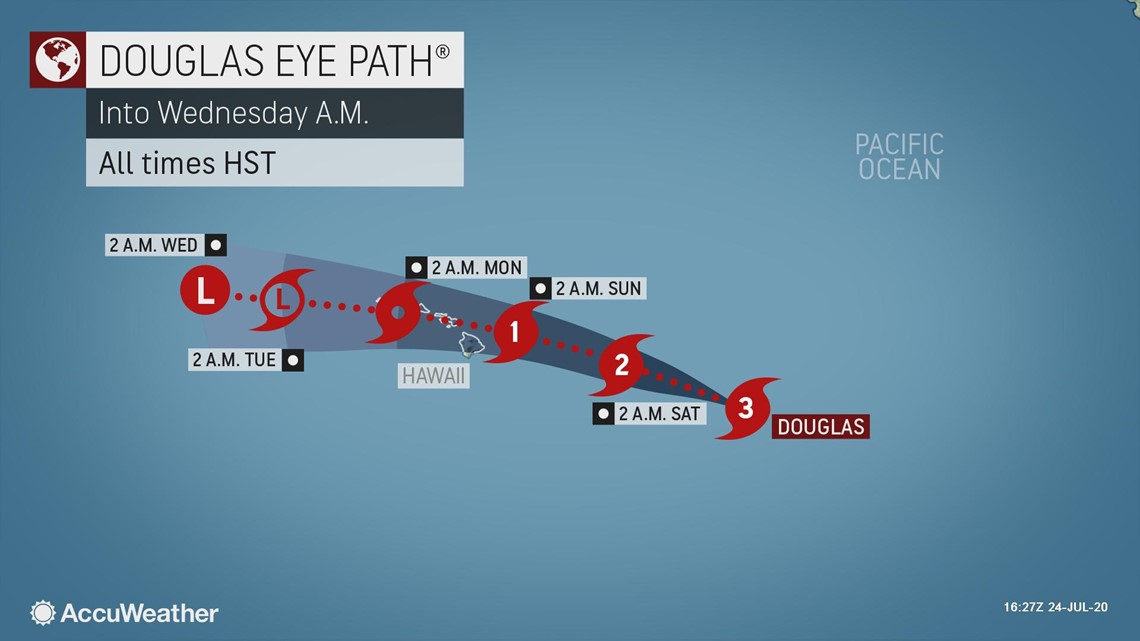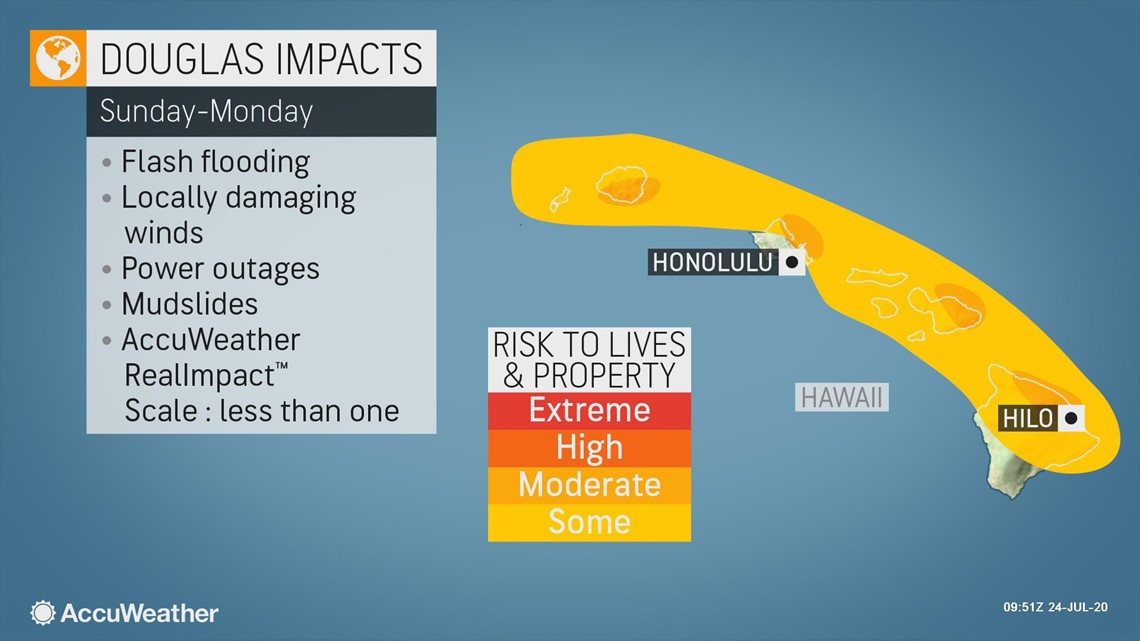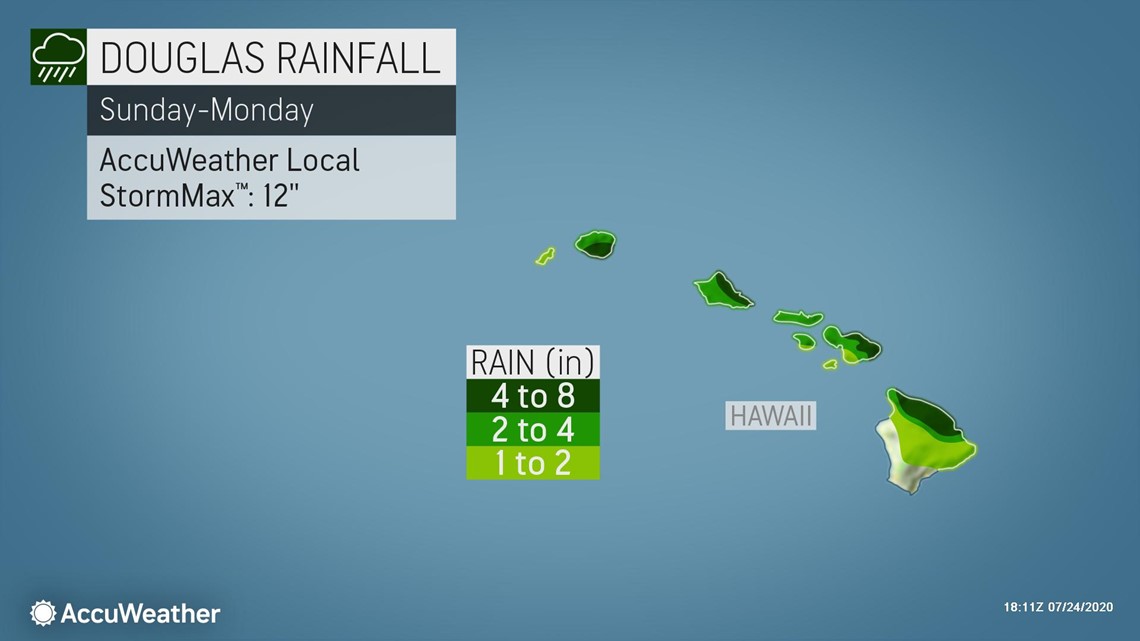After spending some time as a Category 4 hurricane Thursday night, Hurricane Douglas began to lose wind strength on Friday. However, the storm is expected to still be a hurricane as it barrels toward Hawaii by the end of the weekend.
As 5 a.m. Friday, Hawaii time, Douglas was a Category 3 hurricane with maximum sustained winds of 120 mph and was trucking along to the west-northwest at 18 mph. The storm was about 895 miles away from Hilo, Hawaii, and 1,100 miles east of the state capital of Honolulu. At peak intensity, the storm churned through the Pacific with winds of 130 mph.
Douglas is expected to remain a major hurricane (Category 3 strength or higher) through most of Friday. Over the weekend, Douglas will continue to move into a much harsher environment for tropical systems to thrive, which will cause the storm to lose additional wind strength.
While Douglas will have to battle through an area of moderate to high wind shear, AccuWeather forecasters still expect the storm to maintain hurricane strength as it reaches the Hawaiian Islands by the end of the weekend.


In anticipation of Douglas passing near or over the islands, Hawaii Gov. David Ige issued a state of emergency declaration on Thursday.
"Our top priority is always the safety, health and well-being of our residents and visitors. Please take immediate steps to protect your families, loved ones, employees and property," Ige said in a news release.
According to Hawaii News Now, officials are looking at opening emergency shelters, but due to the coronavirus pandemic, some residents may have to shelter in place at home due to a reduced capacity at shelters.
"We have limited shelter space due to COVID-19 guidelines, so we are urging the public to make preparations now to possible shelter in place at your home, or a family or friend's home," Maui Emergency Management Agency administrator Herman Andaya told Hawaii News Now.
The geography of Hawaii will play a big role in the exact track of the storm and therefore the level of impacts across the islands.
"The volcanoes that are on the islands are over thousands of feet high and are like pyramids in the middle of the Pacific Ocean," said AccuWeather Senior Meteorologist Alex Sosnowski. "Hurricanes are low-level storms, and when they run into these volcanic islands they're going to follow the easiest path around."


Because of this, AccuWeather forecasters expect Douglas to travel north of the Big Island, Maui and Molokai with a landfall possible near the town of Kailua on Oahu.
Douglas is forecast to be less than one on the AccuWeather RealImpact™ Scale for Hurricanes as the storm is expected to quickly lose wind intensity as it interacts with the rugged island terrain.
By Monday, Douglas is forecast to be downgraded to a tropical storm and then a tropical depression by Tuesday morning.
Regardless of intensity, Douglas is still expected to bring enough rainfall to cause isolated flash flooding and mudslides across the islands. Winds mainly out of the north from the Big Island to Oahu will keep rainfall totals of 4-8 inches on the northern and eastern sides of the islands.
Winds mainly out of the south on Kauai will keep the highest rainfall totals on the southern side of the island.


An AccuWeather Local StormMax™ of 12 inches of rainfall is possible in the highest elevations.
While Douglas is expected to be a hurricane as it nears Hawaii, hurricane-force winds are not expected to reach the islands. Wind gusts of 40-60 mph are expected to reach the eastern islands late Saturday night or early Sunday and can continue throughout the day on Monday.
AccuWeather Senior Meteorologist Alan Reppert warns that stronger winds out of the northwest and the south, wind directions not typical for the islands, could cause more damage than expected.


This can also bring larger waves from a direction that is usually not expected with predominantly east trade winds.
Winds will gradually dissipate into the middle of the week as the storm loses wind strength and moves away to the west.
Despite sitting in the middle of the Pacific, Hawaii doesn't get struck by many powerful hurricanes. Hurricane Lane came dangerously close in 2018 but didn't make landfall. It did, however, unleash record-breaking rainfall.
Arguably the most devastating storm in Hawaii's recorded history was Iniki in September 1992 when it caused billions of dollars in damage. Winds were recorded at 145 mph, and over 1,421 houses were destroyed.
Two tropical systems passed near Hawaii during the 2019 tropical season. Hurricane Erik passed just south of the Big Island as a tropical storm, before degenerating into a tropical depression on Aug 4. Shortly thereafter, Hurricane Flossie passed close to the islands as a tropical depression on Aug. 6 before dissipating north of the Big Island.
Hurricane Olivia in September 2018 was the last tropical system to bring direct impacts to the islands. The storm made landfall on Maui and Lanai as a tropical storm, which was the first landfall on these islands in recorded history.

